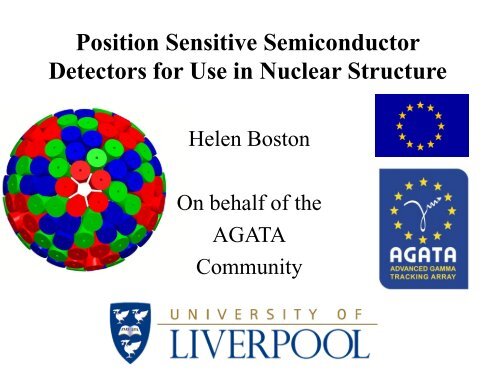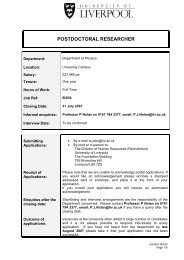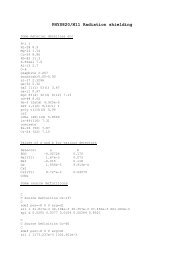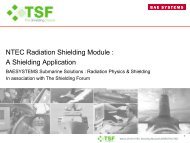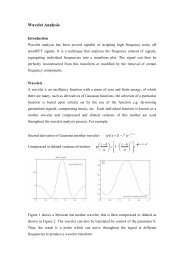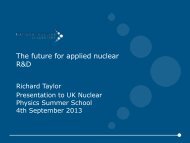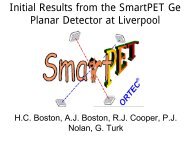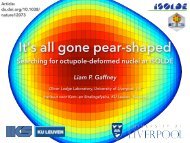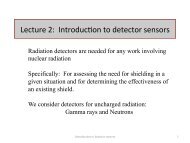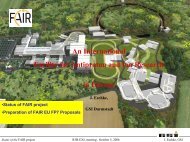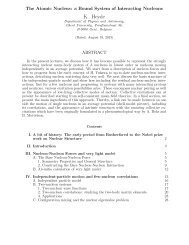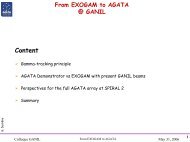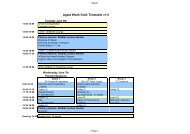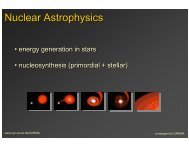AGATA - Nuclear Physics - University of Liverpool
AGATA - Nuclear Physics - University of Liverpool
AGATA - Nuclear Physics - University of Liverpool
You also want an ePaper? Increase the reach of your titles
YUMPU automatically turns print PDFs into web optimized ePapers that Google loves.
Position Sensitive Semiconductor<br />
Detectors for Use in <strong>Nuclear</strong> Structure<br />
Helen Boston<br />
On behalf <strong>of</strong> the<br />
<strong>AGATA</strong><br />
Community
Introduction<br />
• Challenges ahead for <strong>Nuclear</strong> <strong>Physics</strong> experiments<br />
• <strong>AGATA</strong> – The Advanced GAmma Tracking Array<br />
• Pulse Shape Analysis (PSA)<br />
• Gamma Ray Tracking (GRT)<br />
• Expected results<br />
• Time line<br />
• Future experiments
Experimental Conditions and Challenges<br />
FAIR<br />
SPIRAL2<br />
SPES<br />
REX-ISOLDE<br />
EURISOL<br />
ECOS<br />
• Low intensity<br />
• High backgrounds<br />
• Large Doppler broadening<br />
• High counting rates<br />
• High g-ray multiplicities<br />
Need instrumentation<br />
High efficiency<br />
High sensitivity<br />
High throughput<br />
Ancillary detectors
Future Arrays<br />
• Next generation g-ray spectrometer based on gammaray<br />
tracking<br />
• First “real” 4 germanium array no Compton<br />
suppression shields<br />
• Versatile spectrometer with very high efficiency and<br />
excellent spectrum quality for radioactive and high<br />
intensity stable beams
The Concept<br />
Without<br />
Compton<br />
suppression<br />
shields<br />
Compton<br />
continuum.<br />
=> Large<br />
peak to<br />
total ratio<br />
With BGO<br />
shielding<br />
With highly<br />
segmented<br />
detectors<br />
E<br />
'<br />
g<br />
<br />
1<br />
( E<br />
g<br />
E<br />
/ mc<br />
g<br />
2<br />
)(1 cos<br />
)<br />
Less solid<br />
angle<br />
coverage<br />
=> Big drop in<br />
efficiency<br />
Path <strong>of</strong> g-ray reconstructed to form<br />
full energy event<br />
=> Compton continuum reduced<br />
=> Excellent efficiency ~50% @1MeV<br />
=> Greatly improved angular<br />
resolution (~1 0 ) to reduce Doppler<br />
effects<br />
Gamma-ray tracking arrays
The <strong>AGATA</strong> Concept<br />
• Spherical array <strong>of</strong> 180 asymmetric HPGe detectors<br />
• Each detector has a 36-fold segmented outer<br />
Contact ( FWHM ~ 2keV @ 1.3MeV)<br />
• The crystal ;<br />
• 90mm long<br />
• 40mm Maximum<br />
diameter (10 o taper)<br />
P +<br />
• Completed array - HPGe covers<br />
full 4 solid angle<br />
back<br />
+4000V<br />
n +<br />
front
<strong>AGATA</strong><br />
(Design and characteristics)<br />
4 g-array for <strong>Nuclear</strong> <strong>Physics</strong> Experiments at European accelerators<br />
providing radioactive and stable beams<br />
Main features <strong>of</strong> <strong>AGATA</strong><br />
Efficiency: 43% (M g =1) 28% (M g =30)<br />
today’s arrays ~10% (gain ~4) 5% (gain ~1000)<br />
Peak/Total: 58% (M g =1) 49% (M g =30)<br />
today ~55% 40%<br />
Angular Resolution: ~1º <br />
FWHM (1 MeV, v/c=50%) ~ 6 keV !!!<br />
today<br />
~40 keV<br />
Rates: 3 MHz (M g =1) 300 kHz (M g =30)<br />
today 1 MHz 20 kHz<br />
• 180 large volume 36-fold segmented Ge crystals in 60 triple-clusters , 12<br />
pentagonals<br />
• Shell <strong>of</strong> Ge with inner radius <strong>of</strong> 23.5cm will consist <strong>of</strong> 230kg <strong>of</strong> Germanium<br />
• Solid angle coverage <strong>of</strong> 80%<br />
• Digital electronics and sophisticated Pulse Shape Analysis algorithms allow<br />
operation <strong>of</strong> Ge detectors in position sensitive mode g-ray tracking
Position Sensitive Detectors<br />
Highly segmented detectors<br />
• Each event x, y, z, t, E<br />
• x, y, z determined with PSA (IC + RC)<br />
/ mc<br />
• Experimental pulse shapes are compared to theoretical<br />
basis<br />
- Impossible to scan 180 detectors<br />
- Simulation can be adapted as neutron damage<br />
occurs<br />
• Tracking: Compton scatter formula relates scatter<br />
angle to energy deposited<br />
- Allows reconstruction <strong>of</strong> FEE<br />
- Increases P/T<br />
- Optimum use <strong>of</strong> HPGe coverage<br />
E<br />
'<br />
g<br />
<br />
1<br />
( E<br />
g<br />
E<br />
g<br />
2<br />
)(1 cos<br />
)
Ingredients <strong>of</strong> g-Tracking<br />
g<br />
1<br />
Highly segmented<br />
HPGe detectors<br />
Identified<br />
interaction<br />
points<br />
(x,y,z,E,t) i<br />
4<br />
Reconstruction <strong>of</strong> tracks<br />
e.g. by evaluation <strong>of</strong><br />
permutations<br />
<strong>of</strong> interaction points<br />
·<br />
· ·<br />
·<br />
Pulse Shape Analysis<br />
to decompose<br />
recorded waves<br />
2 3<br />
Digital electronics<br />
to record and<br />
process segment<br />
signals<br />
reconstructed g-rays
Pulse Shape Analysis (PSA)<br />
• Location <strong>of</strong> the interaction position within detector<br />
gathered by parameterisation <strong>of</strong> the information from<br />
the pulse shape<br />
• Real charge deposited and transient charges observed<br />
100%<br />
T90<br />
T50<br />
50%<br />
DE<br />
T30<br />
0%
Magnitude (keV)<br />
Magnitude (keV)<br />
Magnitude (keV)<br />
X Y position<br />
Image charge asymmetry varies as a function <strong>of</strong><br />
lateral interaction position<br />
- Calibration <strong>of</strong> asymmetry response<br />
Pixilation 5x5x20mm becomes 1mm 3<br />
Asymmetry<br />
<br />
Area<br />
Area<br />
left<br />
left<br />
<br />
<br />
Area<br />
Area<br />
right<br />
right<br />
700<br />
AC03<br />
700<br />
AC04<br />
700<br />
AC05<br />
700<br />
AC06<br />
700<br />
AC07<br />
600<br />
600<br />
600<br />
600<br />
600<br />
500<br />
500<br />
500<br />
500<br />
500<br />
400<br />
400<br />
400<br />
400<br />
400<br />
300<br />
300<br />
300<br />
300<br />
300<br />
200<br />
200<br />
200<br />
200<br />
200<br />
100<br />
100<br />
100<br />
100<br />
100<br />
0<br />
0 1000 2000 3000<br />
Time (ns)<br />
0<br />
0 1000 2000 3000<br />
Time (ns)<br />
0<br />
0 1000 2000 3000<br />
Time (ns)<br />
0<br />
0 1000 2000 3000<br />
Time (ns)<br />
0<br />
0 1000 2000 3000<br />
Time (ns)<br />
h<br />
e
Azimuthal Detector Sensitivity<br />
r = 24mm<br />
z = 7.3mm<br />
= 124.1 o<br />
F1<br />
A1<br />
E1<br />
0 o<br />
B1<br />
D1<br />
C1
21<br />
Azimuthal Detector Sensitivity<br />
r = 24mm<br />
z = 7.3mm<br />
= 133.7 o<br />
F1<br />
A1<br />
E1<br />
0 o<br />
B1<br />
D1<br />
C1
Azimuthal Detector Sensitivity<br />
r = 24mm<br />
z = 7.3mm<br />
= 143.2 o<br />
F1<br />
A1<br />
E1<br />
0 o<br />
B1<br />
D1<br />
C1
Azimuthal Detector Sensitivity<br />
r = 24mm<br />
z = 7.3mm<br />
= 152.8 o<br />
F1<br />
A1<br />
E1<br />
0 o<br />
B1<br />
D1<br />
C1
Azimuthal Detector Sensitivity<br />
r = 24mm<br />
z = 7.3mm<br />
= 162.3 o<br />
F1<br />
A1<br />
E1<br />
0 o<br />
B1<br />
D1<br />
C1
Azimuthal Detector Sensitivity<br />
r = 24mm<br />
z = 7.3mm<br />
= 171.9 o<br />
F1<br />
A1<br />
E1<br />
0 o<br />
B1<br />
D1<br />
C1
Depth Position<br />
• Depth <strong>of</strong><br />
position<br />
gained<br />
from side<br />
scan<br />
• Asymmetry<br />
• D6 and D1<br />
no<br />
neighbour<br />
segments<br />
so area<br />
divided by<br />
gamma ray<br />
energy
Pulse Shape Analysis : Current Status<br />
Results from the analysis <strong>of</strong> an in-beam test with the first triple module,<br />
e.g. Doppler correction <strong>of</strong> gamma-rays using PSA results<br />
d( 48 Ti,p) 49 Ti, v/c ~6.5%<br />
REACTION CHANNEL: (d,p)<br />
Best result<br />
γ detector,<br />
seg. mult. 1<br />
Full<br />
dataset<br />
Simulation<br />
FWHM FWHM FWHM<br />
1382 keV<br />
Psa<br />
Seg<br />
Det<br />
Detector 32 keV 35 keV<br />
Segment 11.1 keV 12 keV<br />
PSA 4.8 keV 5.3 keV 5.0 keV<br />
Results obtained with Grid Search PSA algorithm (R.Venturelli et al.)<br />
Many different methods are under development
Gamma Ray Tracking (GRT)<br />
• Basic assumptions w.r.t. Energy and Klein Nishina<br />
• 1 st interaction deposits most energy<br />
• Scatter will be forward focused
Expected Results<br />
• Simulation <strong>of</strong><br />
rotational band<br />
structure<br />
emitted by a<br />
recoiling<br />
nucleus with<br />
very high<br />
velocity<br />
• Gain in<br />
efficiency and<br />
resolution<br />
=50%<br />
Agata: FWHM(1.3 MeV)~6 keV<br />
Euroball: FWHM(1.3 MeV)~60 keV<br />
From W Lopez-Martens
Characterisation and Scanning<br />
Comparison <strong>of</strong> real and calculated pulse shapes. Validate codes.<br />
Coincidence scan for<br />
3D position determination<br />
Three symmetric capsules scanned<br />
in <strong>Liverpool</strong><br />
374<br />
keV<br />
662<br />
keV<br />
288<br />
keV<br />
Commissioning <strong>of</strong> further scanning<br />
systems<br />
at Orsay and GSI<br />
Scan <strong>of</strong> an asymmetric capsule C001<br />
in <strong>Liverpool</strong> - now
<strong>Liverpool</strong> Scanning Table<br />
• Calibration <strong>of</strong> the detector response as a function <strong>of</strong> interaction position.<br />
• Scanning asymmetric detector with a collimated beam <strong>of</strong> mono-energetic photons.
Intensity Pr<strong>of</strong>ile – 662keV<br />
Intensity pr<strong>of</strong>ile – 662keV<br />
• Max count = 1400 in front<br />
• Background = 100 cps<br />
• ~500 keV CFD threshold<br />
• 60s per position<br />
• 920MBq Cs-137 source<br />
• 1mm steps<br />
• 1mm diameter collimator<br />
z
Intensity Pr<strong>of</strong>ile – 662keV<br />
• Detector<br />
rotated and<br />
scanned<br />
along the<br />
depth <strong>of</strong> the<br />
detectors
Coincidence Front Face Scan<br />
374keV in <strong>AGATA</strong> and 288keV in the BGO detectors
Coincidence Scan Positions<br />
Line 5<br />
Line 13<br />
Line 1<br />
Line 2<br />
Line 6<br />
Line 3<br />
Line 4<br />
Azimuth 3<br />
F<br />
A<br />
E<br />
Azimuth 4<br />
B<br />
D<br />
Line 18<br />
Line 7<br />
Line 8<br />
Line 9<br />
Azimuth 2<br />
Line 17<br />
Azimuth 1<br />
Line 16<br />
C<br />
Line 15<br />
Line 12<br />
Line 11 Line 14<br />
Line 10<br />
• √r, grid adopted<br />
• 1200 positions<br />
0 o
Electric Field Simulations : MGS<br />
I<br />
Geometry<br />
II<br />
Potential<br />
Elec field<br />
III<br />
Drift<br />
velocities<br />
IV<br />
Weightin<br />
g fields<br />
• Electric field simulations have<br />
been performed and detailsed<br />
comparisons have been made<br />
with experimental pulse shape<br />
data.<br />
<strong>AGATA</strong> symmetric crystal<br />
simulation<br />
Gamma-ray tracking arrays
<strong>AGATA</strong> Triple – Detector Module<br />
First prototype summer 2005<br />
3 encapsulated asymmetric Ge crystals in one cryostat<br />
111 preamplifiers with cold FET<br />
~230 vacuum feedthroughs<br />
LN 2<br />
dewar, 3 litre, cooling power ~8 watts
The <strong>AGATA</strong> timescale<br />
3 different<br />
asymmetric<br />
hexagonal shapes are<br />
used<br />
Triple cluster<br />
modular units in a<br />
single cryostat<br />
The <strong>AGATA</strong><br />
demonstrator: 5 triple<br />
clusters, 540<br />
segments. Scheduled<br />
for completion 2010<br />
Completed array (6480<br />
segments) with support<br />
structure<br />
2 <strong>of</strong><br />
completed<br />
array
<strong>AGATA</strong> Experimental Program<br />
Efficiency (%)<br />
2009 LNL<br />
6TC<br />
2010 GANIL/SPIRAL<br />
≥ 8TC<br />
2012 GSI / FRS<br />
~15TC (1)<br />
<strong>AGATA</strong> D. + PRISMA<br />
<strong>AGATA</strong> radius<br />
23.5 cm<br />
Eff (%)<br />
vs. distance<br />
<strong>AGATA</strong> + VAMOS<br />
<strong>AGATA</strong> D. ≥8TC<br />
EXOGAM 8 seg. Clovers<br />
Total Eff. > 10%<br />
Setup works also as<br />
Compton Polarimeter<br />
<strong>AGATA</strong> @ FRS<br />
50<br />
45<br />
40<br />
35<br />
30<br />
25<br />
20<br />
15<br />
Solid Angle (%)<br />
Efficiency M = 1<br />
Efficiency M = 10<br />
Efficiency M = 20<br />
Efficiency M = 30<br />
= 0 = 0.5<br />
6%<br />
<strong>AGATA</strong> D.<br />
LNL<br />
13.5 cm<br />
10<br />
5<br />
0<br />
1 2
Commissioning Preliminary Plan<br />
- Phase 0: commissioning with radioactive sources starting<br />
when detectors and electronics are available<br />
(even partially).<br />
- Phase 1: easy test with tandem beams with no ancillary<br />
detectors. Radiative capture or fusion-evaporation<br />
reactions with light targets in inverse kinematics.<br />
- Phase 2: test with a “simple” ancillary detector with<br />
limited number <strong>of</strong> parameters (DANTE).<br />
Coulomb excitation reactions with medium mass<br />
beams (A
• March 2009 at Legnaro<br />
• 1 asymmetric triple <strong>AGATA</strong> detector<br />
• 30 Si@70MeV + 12 C (216mg/cm 2 )<br />
• Two detector<br />
positions :<br />
close (5.5 cm)<br />
for 54h<br />
far (23.5 cm)<br />
for 20h<br />
• 14TB data<br />
• >1M events in<br />
1823keV peak<br />
Latest In-beam Test<br />
40<br />
K<br />
1823 keV<br />
40<br />
K<br />
2333 keV
The <strong>AGATA</strong> Demonstrator<br />
Objective <strong>of</strong> the final R&D phase 2003-2010<br />
1 symmetric triple-cluster<br />
5 asymmetric triple-clusters<br />
36-fold segmented crystals<br />
540 segments<br />
555 digital-channels<br />
Eff. 3 – 8 % @ M g = 1<br />
Eff. 2 – 4 % @ M g = 30<br />
Full EDAQ<br />
with on line PSA and g-ray tracking<br />
In beam Commissioning<br />
Technical proposal for full array<br />
Cost ~ 6 M € Capital
<strong>AGATA</strong> demonstrator at Legnaro<br />
(2009-10)<br />
5 triple clusters coupled to PRISMA<br />
Schematics <strong>of</strong> the mounting frame<br />
holding (up to) 15 clusters<br />
Peak efficiency<br />
3 – 8 % @ M g = 1<br />
2 – 4 % @ M g = 30
<strong>AGATA</strong> Demonstrator at Legnaro<br />
Principal physics opportunities :<br />
High-spin spectroscopy <strong>of</strong><br />
moderately neutron-rich nuclei<br />
produced in deep-inelastic reactions<br />
Good experience from CLARA + Prisma<br />
Heavy-ion beams from PIAVE + ALPI<br />
with suitable intensities and energies
<strong>AGATA</strong> Demonstrator at GANIL<br />
Main physics opportunities:<br />
(~2010/11)<br />
• Spectroscopy <strong>of</strong> heavy elements towards SHE<br />
• Gamma-ray spectroscopy <strong>of</strong> neutron-rich nuclei<br />
populated in Deep Inelastic Reaction (with the GANIL<br />
specific aspects)<br />
• Gamma-ray spectroscopy with reactions at intermediate<br />
energies (up to 50 A.MeV)<br />
• Classical high-spin physics and exotic shapes<br />
Range <strong>of</strong> beams, fragmentation, SPIRAL, direct beam line
<strong>AGATA</strong> Post-Demonstrator Array at GSI ~ 2012<br />
Main physics opportunities:<br />
Gamma-ray spectroscopy with reactions<br />
at relativistic energies (> 50 A.MeV) - Coulomb excitation, few nucleon<br />
removal etc<br />
with slowed-down beams (10-20 A.MeV) - direct reactions, inelastic<br />
scattering
Summary<br />
• Challenges ahead for nuclear spectroscopy<br />
• New Arrays such as <strong>AGATA</strong> use highly segmented detectors to<br />
gain position sensitivity and allow gamma ray tracking<br />
• <strong>AGATA</strong> at Legnaro<br />
• Shell evolution in neutron-rich nuclei and high-spin states<br />
in island <strong>of</strong> inversion etc<br />
• <strong>AGATA</strong> at GANIL<br />
• High-spin spectroscopy <strong>of</strong> neutron-rich nuclei populated in<br />
deep inelastic reactions, studies <strong>of</strong> proton-rich nuclei and<br />
proton-neutron pairing correlations<br />
• <strong>AGATA</strong> at GSI<br />
• Proton drip-line and N=Z physics, neutron-rich nuclei,<br />
shell melting and studies along the r-process path
Acknowledgements<br />
A.J. Boston a , R.J. Cooper a , J.R. Cresswell a , M.R.<br />
Dimmock a , I. Lazarus b , S. Moon a L. Nelson a ,<br />
P.J. Nolan a , J. Simpson b , C. Unsworth a .<br />
a<br />
Oliver Lodge Laboratory, The <strong>University</strong> <strong>of</strong><br />
<strong>Liverpool</strong>, UK<br />
b<br />
STFC Daresbury Laboratory, Daresbury,<br />
Warrington , UK<br />
On behalf <strong>of</strong> the <strong>AGATA</strong> Collaboration
HPGe Specifications<br />
• Hexaconical Ge crystals:<br />
- 90 mm long.<br />
- 80 mm max diameter.<br />
- 36 segments, 1 centre contact<br />
- Al encapsulation, 0.6 mm spacing,<br />
• Symmetric detectors<br />
– 3 delivered<br />
• Asymmetric detectors<br />
– 19 ordered (9 accepted, 4 in test, 2<br />
not accepted, 4 to be delivered)<br />
• Preamplifiers available<br />
– Core (Cologne);<br />
– Segment (Ganil & Milano)<br />
• Test cryostats for characterisation<br />
– 5 delivered<br />
• Triple cryostats<br />
– 5 ordered<br />
– 1 complete, 2 being assembled, 2<br />
ordered<br />
0.8 mm thickness.<br />
-37 vacuum feed-throughs.
<strong>AGATA</strong> : Advanced GAmma<br />
Tracking Array<br />
CAARI 2008<br />
Helen Boston<br />
On behalf <strong>of</strong> the <strong>AGATA</strong> Community
Digital Electronics<br />
o Digital sampling <strong>of</strong> preamplifier response allows analysis <strong>of</strong> pulse shape<br />
o CCLRC Daresbury designed GRT4 cards currently in use<br />
The GRT4 Cards<br />
4-channel VME cards<br />
14 bit, 80MHz FADCs<br />
2 XILINX Spartan II FPGAs per input provide:<br />
• Buffering<br />
• Internal CFD<br />
• Event timestamp<br />
• Energy calculation via Moving Window<br />
Deconvolution<br />
Count rate limited by data readout through VME<br />
bus (40Mb/s/crate)
Efficiency (%)<br />
<strong>AGATA</strong>-15 at the GSI-FRS<br />
Forward Quadrant with 45 crystals in 15 triple-clusters<br />
50<br />
45<br />
40<br />
35<br />
Solid Angle (%)<br />
Efficiency M = 1<br />
Efficiency M = 10<br />
Efficiency M = 20<br />
Efficiency M = 30<br />
30<br />
25<br />
20<br />
15<br />
10<br />
5<br />
0<br />
= 0 = 50 %<br />
v/c 1 = 0 v/c<br />
2= 0.5


